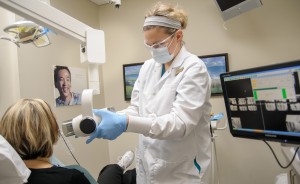How is radiation measured?
Radiation is measured in units called Sieverts. Because of the small amount of radiation emitted during dental x-rays, it is measured in MicroSieverts (one millionth of a Sievert). Many patients are concerned about the amount of radiation we get from dental x-rays, so we’d like to give you something to compare this to.

*Just flying in an airplane exposes us to as much radiation as a full Set of digital bitewings.
*One chest CT is equivalent to getting 1,400 digital bitewings.
How much radiation is significant?
Doses of radiation below 100,000 MicroSieverts indicates that risks of health effects are either too small to be observed or are nonexistent. The bitewing x-rays we take are only 0.03% of this amount! The potential health risk from dental x-rays is far outweighed by the benefit of early cavity detection the x-rays give us.
We consider your personal risk factors when deciding which type and how often you should receive X-rays. We also use exclusively digital X-ray sensors, which reduce radiation exposure by up to 75%. When administered appropriately, dental X-rays provide us with a safe, accurate way to diagnose dental disease.
What about lead aprons?
Digital x-rays use far less radiation than traditional x-rays. We follow the recommendations from the Minnesota Department of Health, and lead aprons are not required for dental x-rays. We recognize that every patient’s situation is unique and therefore, we keep lead aprons and thyroid collars available for use upon request.
